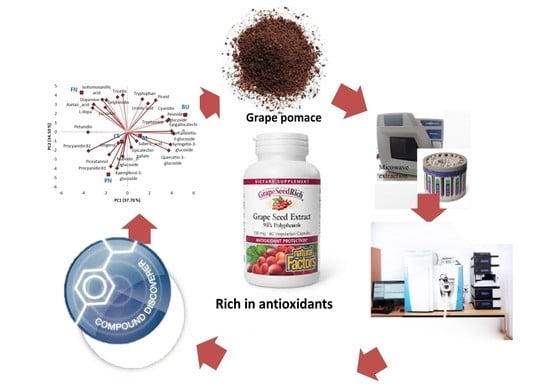Bioactive Phytochemical Composition of Grape Pomace Resulted from Different White and Red Grape Cultivars
Abstract
1. Introduction
2. Materials and Methods
2.1. Grape Sample
Grape Pomace GP
2.2. Chemicals and Reagents
2.3. Extraction Procedures
2.4. Analytical Investigations
2.4.1. Quantitative UV-Vis Spectrophotometric Determinations
2.4.2. Polyphenolic Profile by UHPLC-HRMS
2.5. Data Processing
3. Results and Discussions
3.1. Bioactive Properties
3.2. Identification of Phenolic Compounds in Grape Pomace by UHPLC-HRMS
3.3. Quantitative Data of Phenolic Compounds in Grape Pomace of Different Grape Cultivars
3.4. Multivariate Data Analysis
4. Conclusions
Supplementary Materials
Author Contributions
Funding
Informed Consent Statement
Data Availability Statement
Conflicts of Interest
References
- Balea, S.S.; Pârvu, A.E.; Pop, N.; Marín, F.Z.; Pârvu, M. Polyphenolic compounds, antioxidant, and cardioprotective effects of pomace extracts from Fetească neagră cultivar. Oxid. Med. Cell. Longev. 2018, 2018, 8194721. [Google Scholar] [CrossRef]
- Apolinar-Valiente, R.; Romero-Cascales, I.; Gómez-Plaza, E.; López-Roca, J.M.; Ros-García, J.M. Cell wall compounds of red grapes skins and their grape marcs from three different winemaking techniques. Food Chem. 2015, 187, 89–97. [Google Scholar] [CrossRef]
- Rada, E.C.; Ragazzi, M.; Fiori, L.; Antolini, D. Bio-drying of grape marc and other biomass: A comparison. Water Sci. Technol. 2009, 60, 1065–1070. [Google Scholar] [CrossRef] [PubMed]
- Burcova, Z.; Kreps, F.; Schmidt, S.; Strizincova, P.; Jablonsky, M.; Kyselka, J.; Haz, A.; Surina, I. Antioxidant Activity and the Tocopherol and Phenol Contents of Grape Residues. BioResources 2019, 14, 4146–4156. Available online: https://ojs.cnr.ncsu.edu/index.php/BioRes/article/view/BioRes_14_2_4146_Burcova_Antioxidant_Activity_Tocopherol_Phenol_Contents (accessed on 13 October 2022).
- Negro, C.; Aprile, A.; Luvisi, A.; de Bellis, L.; Miceli, A. Antioxidant Activity and Polyphenols Characterization of Four Monovarietal Grape Pomaces from Salento (Apulia, Italy). Antioxidants 2021, 10, 1406. [Google Scholar] [CrossRef]
- Manach, C.; Scalbert, A.; Morand, C.; Rémésy, C.; Jiménez, L. Polyphenols: Food sources and bioavailability. Am. J. Clin. Nutr. 2004, 79, 727–747. [Google Scholar] [CrossRef]
- Cotoras, M.; Vivanco, H.; Melo, R.; Aguirre, M.; Silva, E.; Mendoza, L. In Vitro and in Vivo Evaluation of the Antioxidant and Prooxidant Activity of Phenolic Compounds Obtained from Grape (Vitis vinifera) Pomace. Molecules 2014, 19, 21154–21167. [Google Scholar] [CrossRef] [PubMed]
- Maicas, S.; Mateo, J.J. Sustainability of Wine Production. Sustainability 2020, 12, 559. [Google Scholar] [CrossRef]
- Muhlack, R.A.; Potumarthi, R.; Jeffery, D.W. Sustainable wineries through waste valorisation: A review of grape marc utilisation for value-added products. Waste Manag. 2018, 72, 99–118. [Google Scholar] [CrossRef]
- Varzakas, T.; Zakynthinos, G.; Verpoort, F. Plant Food Residues as a Source of Nutraceuticals and Functional Foods. Foods 2016, 5, 88. [Google Scholar] [CrossRef]
- Panzella, L.; Moccia, F.; Nasti, R.; Marzorati, S.; Verotta, L.; Napolitano, A. Bioactive Phenolic Compounds From Agri-Food Wastes: An Update on Green and Sustainable Extraction Methodologies. Front. Nutr. 2020, 7, 60. [Google Scholar] [CrossRef] [PubMed]
- Averilla, J.N.; Oh, J.; Kim, H.J.; Kim, J.S.; Kim, J.S. Potential health benefits of phenolic compounds in grape processing by-products. Food Sci. Biotechnol. 2019, 28, 1607–1615. [Google Scholar] [CrossRef] [PubMed]
- Xia, E.Q.; Deng, G.F.; Guo, Y.J.; Li, H.B. Biological Activities of Polyphenols from Grapes. Int. J. Mol. Sci. 2010, 11, 622–646. [Google Scholar] [CrossRef]
- Sabra, A.; Netticadan, T.; Wijekoon, C. Grape bioactive molecules, and the potential health benefits in reducing the risk of heart diseases. Food Chem. X 2021, 12, 100149. [Google Scholar] [CrossRef]
- Rudrapal, M.; Khairnar, S.J.; Khan, J.; Dukhyil, A.B.; Ansari, M.A.; Alomary, M.N.; Alshabrmi, F.M.; Palai, S.; Deb, P.K.; Devi, R. Dietary Polyphenols and Their Role in Oxidative Stress-Induced Human Diseases: Insights Into Protective Effects, Antioxidant Potentials and Mechanism(s) of Action. Front. Pharmacol. 2022, 13, 283. [Google Scholar] [CrossRef] [PubMed]
- Šikuten, I.; Štambuk, P.; Andabaka, Ž.; Tomaz, I.; Marković, Z.; Stupić, D.; Maletić, E.; Kontić, J.K.; Preiner, D. Grapevine as a Rich Source of Polyphenolic Compounds. Moleluces 2020, 25, 5604. [Google Scholar] [CrossRef] [PubMed]
- Castellanos-Gallo, L.; Ballinas-Casarrubias, L.; Espinoza-Hicks, J.C.; Hernández-Ochoa, L.R.; Muñoz-Castellanos, L.N.; Zermeño-Ortega, M.R.; Borrego-Loya, A.; Salas, E. Grape Pomace Valorization by Extraction of Phenolic Polymeric Pigments: A Review. Processes 2022, 10, 469. [Google Scholar] [CrossRef]
- Tapia-Quirós, P.; Montenegro-Landívar, M.F.; Reig, M.; Vecino, X.; Cortina, J.L.; Saurina, J.; Granados, M. Recovery of Polyphenols from Agri-Food By-Products: The Olive Oil and Winery Industries Cases. Foods 2022, 11, 362. [Google Scholar] [CrossRef]
- Gutiérrez-Escobar, R.; Aliaño-González, M.J.; Cantos-Villar, E. Wine Polyphenol Content and Its Influence on Wine Quality and Properties: A Review. Molecules 2021, 26, 718. [Google Scholar] [CrossRef]
- Merkyte, V.; Longo, E.; Windisch, G.; Boselli, E. Phenolic Compounds as Markers of Wine Quality and Authenticity. Foods 2020, 9, 1785. [Google Scholar] [CrossRef]
- Casazza, A.A.; Aliakbarian, B.; de Faveri, D.; Fiori, L.; Perego, P. Antioxidants from winemaking wastes: A study on extraction parameters using response surface methodology. J. Food Biochem. 2012, 36, 28–37. [Google Scholar] [CrossRef]
- Fontana, A.; Antoniolli, A.; Fernández, M.A.D.; Bottini, R. Phenolics profiling of pomace extracts from different grape varieties cultivated in Argentina. RSC Adv. 2017, 7, 29446–29457. [Google Scholar] [CrossRef]
- Yammine, S.; Delsart, C.; Vitrac, X.; Peuchot, M.M.; Ghidossi, R. Characterisation of polyphenols and antioxidant potential of red and white pomace by-product extracts using subcritical water extraction. OENO One 2020, 54, 263–278. [Google Scholar] [CrossRef]
- Rockenbach, I.I.; Rodrigues, E.; Gonzaga, L.V.; Caliari, V.; Genovese, M.I.; Gonalves, A.E.D.S.S.; Fett, R. Phenolic compounds content and antioxidant activity in pomace from selected red grapes (Vitis vinifera L. and Vitis labrusca L.) widely produced in Brazil. Food Chem. 2011, 127, 174–179. [Google Scholar] [CrossRef]
- Georgiev, V.; Ananga, A.; Tsolova, V. Recent Advances and Uses of Grape Flavonoids as Nutraceuticals. Nutrients 2014, 6, 391–415. [Google Scholar] [CrossRef]
- Singleton, V.L.; Rossi, J.A. Colorimetry of Total Phenolics with Phosphomolybdic-Phosphotungstic Acid Reagents. Am. J. Enol. Vitic. 1965, 16, 144–158. [Google Scholar]
- He, Q.; Yao, K.; Jia, D.; Fan, H.; Liao, X.; Shi, B. Determination of total catechins in tea extracts by HPLC and spectrophotometry. Nat. Prod. Res. 2009, 23, 93–100. [Google Scholar] [CrossRef]
- Khanal, R.C.; Howard, L.R.; Prior, R.L. Procyanidin Content of Grape Seed and Pomace, and Total Anthocyanin Content of Grape Pomace as Affected by Extrusion Processing. J. Food Sci. 2009, 74, H174–H182. [Google Scholar] [CrossRef]
- Wang, W.; Jung, J.; Tomasino, E.; Zhao, Y. Optimization of solvent and ultrasound-assisted extraction for different anthocyanin rich fruit and their effects on anthocyanin compositions. LWT Food Sci. Technol. 2016, 72, 229–238. [Google Scholar] [CrossRef]
- Manca, M.L.; Casula, E.; Marongiu, F.; Bacchetta, G.; Sarais, G.; Zaru, M.; Escribano-Ferrer, E.; Peris, J.E.; Usach, I.; Fais, S.; et al. From waste to health: Sustainable exploitation of grape pomace seed extract to manufacture antioxidant, regenerative and prebiotic nanovesicles within circular economy. Sci. Rep. 2020, 10, 14184. [Google Scholar] [CrossRef]
- Sharma, O.P.; Bhat, T.K. DPPH antioxidant assay revisited. Food Chem. 2009, 113, 1202–1205. [Google Scholar] [CrossRef]
- Nichitoi, M.M.; Josceanu, A.M.; Isopescu, R.D.; Isopencu, G.O.; Geana, E.I.; Ciucure, C.T.; Lavric, V. Polyphenolics profile effects upon the antioxidant and antimicrobial activity of propolis extracts. Sci. Rep. 2021, 11, 20113. [Google Scholar] [CrossRef]
- Ayuda-Durán, B.; González-Manzano, S.; Gil-Sánchez, I.; Moreno-Arribas, M.V.; Bartolomé, B.; Sanz-Buenhombre, M.; Guadarrama, A.; Santos-Buelga, C.; González-Paramás, A.M. Antioxidant Characterization and Biological Effects of Grape Pomace Extracts Supplementation in Caenorhabditis elegans. Foods 2019, 8, 75. [Google Scholar] [CrossRef]
- Zhang, S.; Zhu, M.J. Characterization of Polyphenolics in Grape Pomace Extracts Using ESI Q-TOF MS/MS. Food Sci. Nutr. 2015, 1, 1–10. [Google Scholar] [CrossRef]
- Negro, C.; Aprile, A.; Luvisi, A.; Nicolì, F.; Nutricati, E.; Vergine, M.; Miceli, A.; Blando, F.; Sabella, E.; de Bellis, L. Phenolic Profile and Antioxidant Activity of Italian Monovarietal Extra Virgin Olive Oils. Antioxidants. 2019, 8, 161. [Google Scholar] [CrossRef]
- Ferri, M.; Vannini, M.; Ehrnell, M.; Eliasson, L.; Xanthakis, E.; Monari, S.; Sisti, L.; Marchese, P.; Celli, A.; Tassoni, A. From winery waste to bioactive compounds and new polymeric biocomposites: A contribution to the circular economy concept. J. Adv. Res. 2020, 24, 1–11. [Google Scholar] [CrossRef]
- Antoniolli, A.; Fontana, A.R.; Piccoli, P.; Bottini, R. Characterization of polyphenols and evaluation of antioxidant capacity in grape pomace of the cv. Malbec. Food Chem. 2015, 178, 172–178. [Google Scholar] [CrossRef]
- Xu, Y.; Burton, S.; Kim, C.; Sismour, E. Phenolic compounds, antioxidant, and antibacterial properties of pomace extracts from four Virginia-grown grape varieties. Food Sci. Nutr. 2016, 4, 125–133. [Google Scholar] [CrossRef] [PubMed]
- Gurgenidze, L.; Kanchaveli, T.; Kvartskhava, G.; Gurgenidze, L.; Kanchaveli, T.; Kvartskhava, G. Selecting optimal parameters for obtaining the extract of red grape pomace. Rev. Fac. Nac. Agron. Medellín 2022, 75, 9831–9837. [Google Scholar] [CrossRef]
- Vojáčkova, K.; Mlček, J.; Škrovankova, S.; Adamkova, A.; Adamek, M.; Orsavova, J.; Bučkova, M.; Fic, V.; Kouřimska, L.; Buran, M. Biologically active compounds contained in grape pomace. Potravin. Slovak. J. Food Sci. 2020, 14, 854–861. [Google Scholar] [CrossRef]
- Rajha, H.N.; el Darra, N.; Hobaika, Z.; Boussetta, N.; Vorobiev, E.; Maroun, R.G.; Louka, N. Extraction of Total Phenolic Compounds, Flavonoids, Anthocyanins and Tannins from Grape Byproducts by Response Surface Methodology. Influence of Solid-Liquid Ratio, Particle Size, Time, Temperature and Solvent Mixtures on the Optimization Process. Food Nutr. Sci. 2014, 5, 397–409. [Google Scholar] [CrossRef]
- Ribeiro, L.F.; Ribani, R.H.; Stafussa, A.P.; Makara, C.N.; Branco, I.G.; Maciel, G.M.; Haminiuk, C.W.I. Exploratory analysis of bioactive compounds and antioxidant potential of grape (Vitis vinifera) pomace. Acta Sci. Technol. 2022, 44, e56934. [Google Scholar] [CrossRef]
- Kammerer, D.; Claus, A.; Carle, R.; Schieber, A. Polyphenol Screening of Pomace from Red and White Grape Varieties (Vitis vinifera L.) by HPLC-DAD-MS/MS. J. Agric. Food Chem. 2004, 52, 4360–4367. [Google Scholar] [CrossRef]
- Ciucure, C.T.; Geana, E.I.; Sandru, C.; Tita, O.; Botu, M. Phytochemical and Nutritional Profile Composition in Fruits of Different Sweet Chestnut (Castanea sativa Mill.) Cultivars Grown in Romania. Separations 2022, 9, 66. [Google Scholar] [CrossRef]
- Hohrenk, L.L.; Itzel, F.; Baetz, N.; Tuerk, J.; Vosough, M.; Schmidt, T.C. Comparison of Software Tools for Liquid Chromatography-High-Resolution Mass Spectrometry Data Processing in Nontarget Screening of Environmental Samples. Anal. Chem. 2020, 92, 1898–1907. [Google Scholar] [CrossRef]
- Milinčić, D.D.; Stanisavljević, N.S.; Kostić, A.; Bajić, S.S.; Kojić, M.O.; Gašić, U.M.; Barać, M.B.; Stanojević, S.P.; Tešić, Ž.L.; Pešić, M.B. Phenolic compounds and biopotential of grape pomace extracts from Prokupac red grape variety. LWT 2021, 138, 110739. [Google Scholar] [CrossRef]
- Hassani, S.; Akmal, M.R.; Salek-Maghsoudi, A.; Rahmani, S.; Ganjali, M.R.; Norouzi, P.; Abdollahi, M. Novel label-free electrochemical aptasensor for determination of Diazinon using gold nanoparticles-modified screen-printed gold electrode. Biosens. Bioelectron. 2018, 120, 122–128. [Google Scholar] [CrossRef]
- Rahman, M.M.; Rahaman, M.S.; Islam, M.R.; Rahman, F.; Mithi, F.M.; Alqahtani, T.; Almikhlafi, M.A.; Alghamdi, S.Q.; Alruwaili, A.S.; Hossain, M.S.; et al. Role of Phenolic Compounds in Human Disease: Current Knowledge and Future Prospects. Molecules 2021, 27, 233. [Google Scholar] [CrossRef]
- Peixoto, C.M.; Dias, M.I.; Alves, M.J.; Calhelha, R.C.; Barros, L.; Pinho, S.P.; Ferreira, I.C.F.R. Grape pomace as a source of phenolic compounds and diverse bioactive properties. Food Chem. 2018, 253, 132–138. [Google Scholar] [CrossRef] [PubMed]
- Davidson, M.; Rashidi, N.; Nurgali, K.; Apostolopoulos, V. The Role of Tryptophan Metabolites in Neuropsychiatric Disorders. Int. J. Mol. Sci. 2022, 23, 9968. [Google Scholar] [CrossRef] [PubMed]
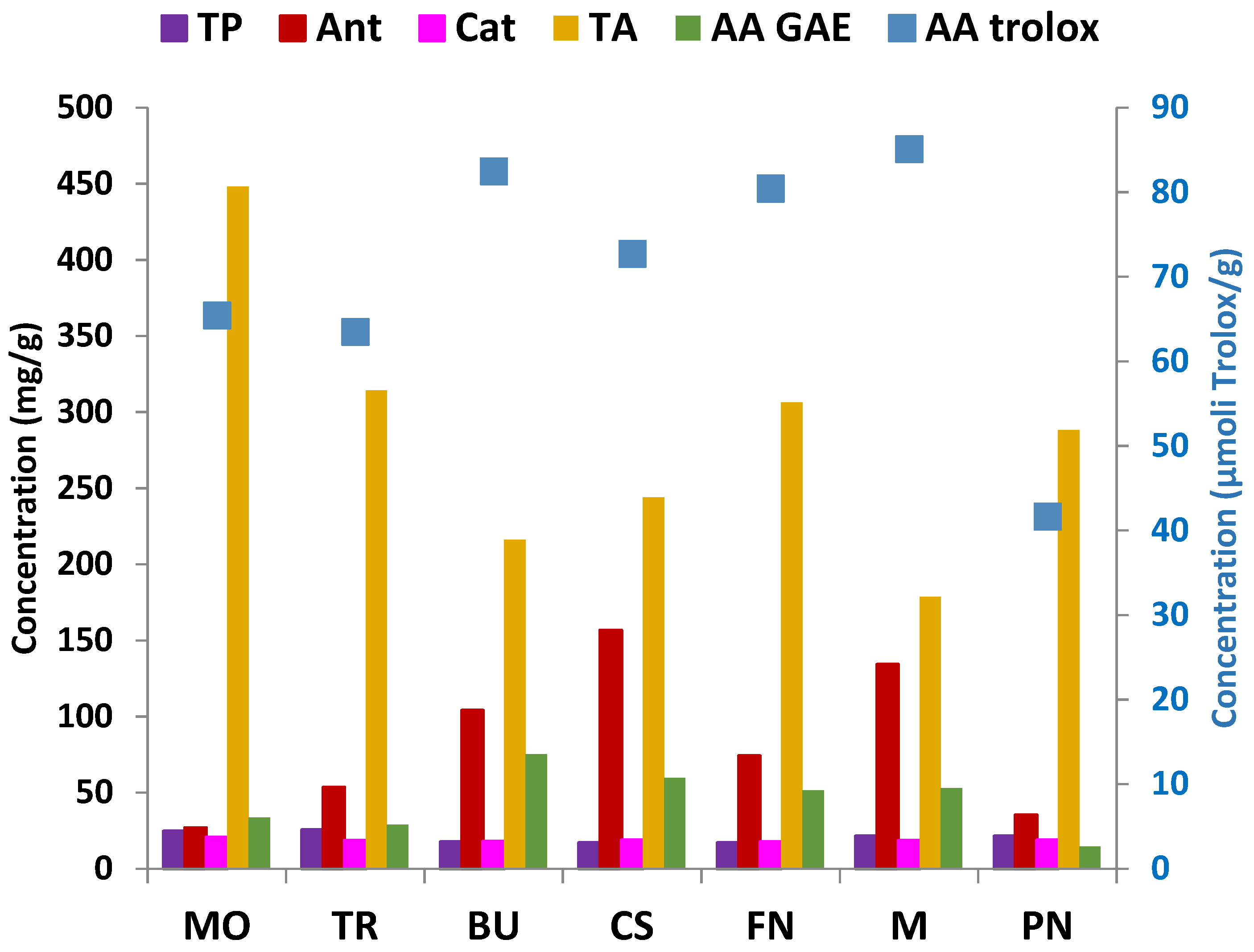
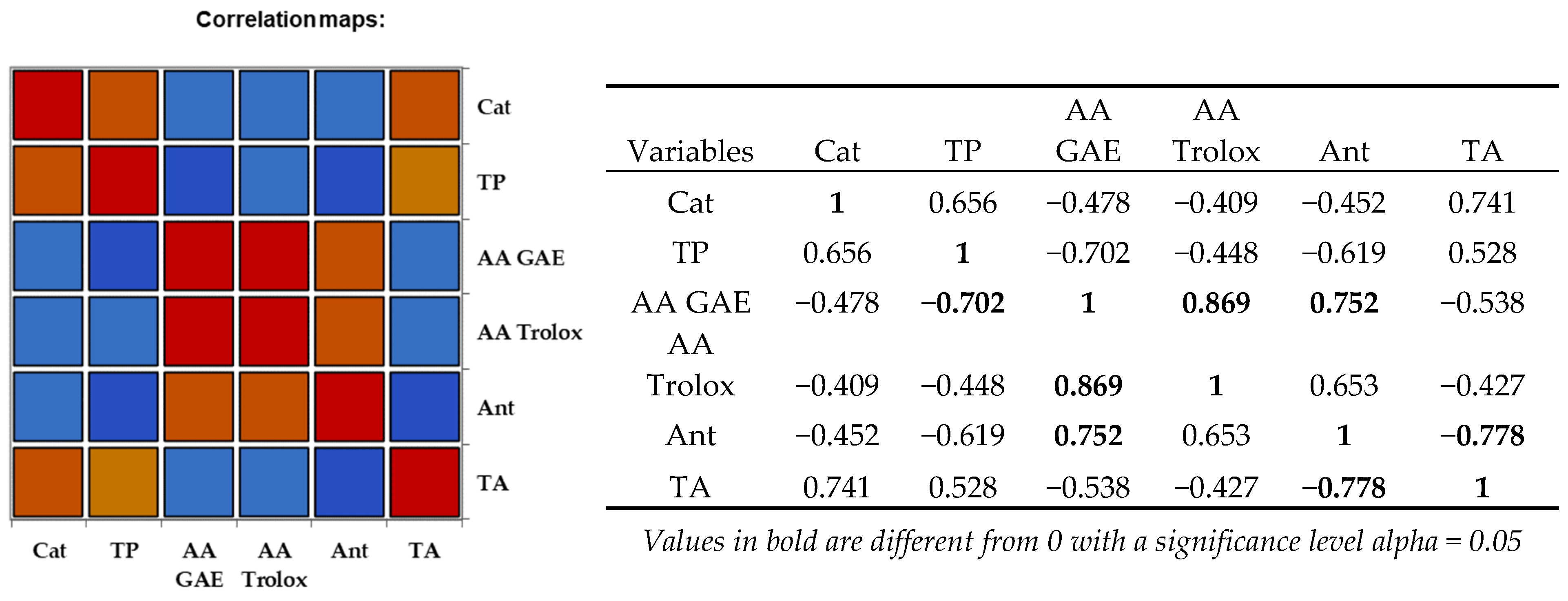
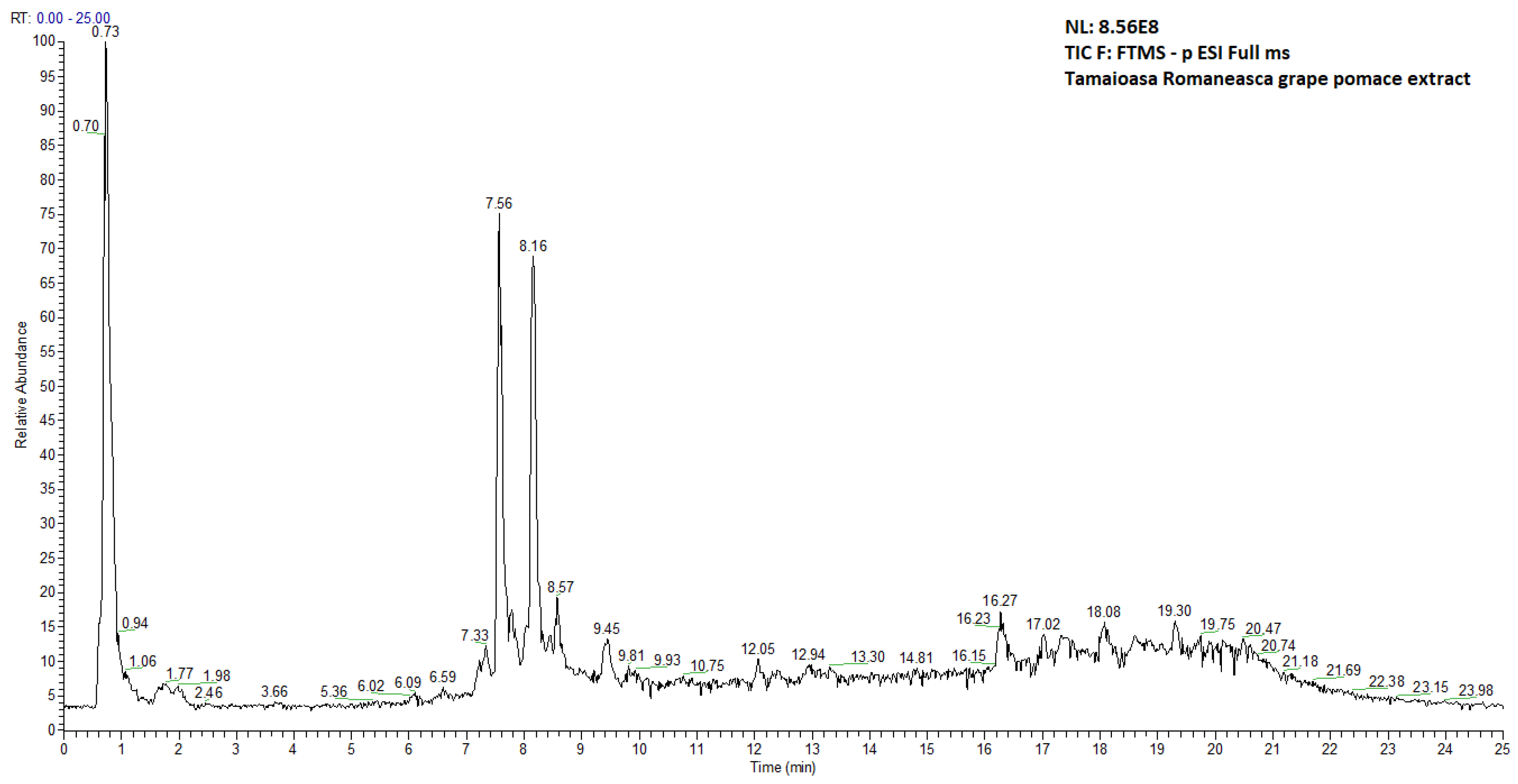

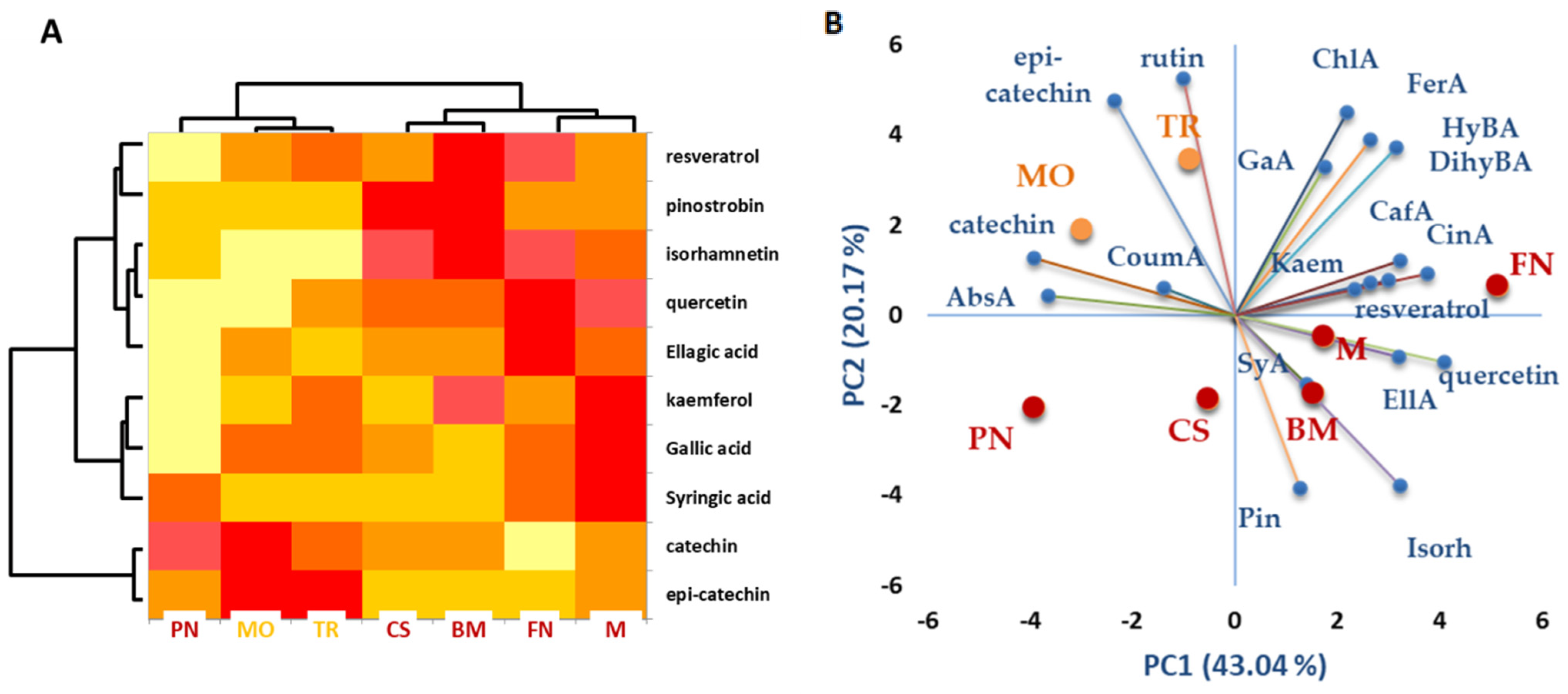

| No | Compound | Retention Time (min) | Formula | Exact Mass | Accurate Mass (M-H)− | Experimental Adduct Ion (m/z) | Mass Fragments |
|---|---|---|---|---|---|---|---|
| Phenolic acids | |||||||
| 1 | Gallic acid | 1.98 | C7H6O5 | 170.0215 | 169.0142 | 169.0133 | 125.0231 |
| 2 | 3,4-Dihydroxybenzoic acid | 4.26 | C7H6O4 | 154.0266 | 153.0193 | 153.0184 | 109.0281 |
| 3 | 4-Hydroxybenzoic acid | 6.51 | C7H6O3 | 138.0316 | 137.0243 | 137.0233 | 118.9650, 96.9588, 71.0124 |
| 4 | t-Ferulic acid | 7.82 | C10H10O4 | 194.0579 | 193.0506 | 193.0499 | 178.0262, 134.0361 |
| 5 | Chlorogenic acid | 7.90 | C16H18O9 | 354.0950 | 353.0877 | 353.0880 | 191.0553 |
| 6 | Caffeic acid | 8.03 | C9H8O4 | 180.0422 | 179.0349 | 179.0343 | 135.044 |
| 7 | Syringic acid | 8.44 | C9H10O5 | 198.0528 | 197.0455 | 197.0450 | 182.0212, 166.9976, 153.0547, 138.0311, 123.0075 |
| 8 | Cinnamic acid | 8.45 | C9H8O2 | 148.0524 | 147.0451 | 147.0442 | 119.0489, 103.0387 |
| 9 | p-Coumaric acid | 8.72 | C9H8O3 | 164.0473 | 163.0400 | 163.0390 | 119.0489 |
| Flavonoids | |||||||
| 10 | Catechin | 7.57 | C15H14O6 | 290.0790 | 289.0717 | 289.0719 | 109.0282, 123.0349, 125.0232, 137.0232, 151.0390, 203.0708 |
| 11 | Epi-catechin | 8.14 | C15H14O6 | 290.0790 | 289.0717 | ||
| 12 | Rutin | 9.42 | C27H30O16 | 610.1533 | 609.1460 | 609.1473 | 301.0352, 300.0276 |
| 13 | Naringin | 8.99 | C27H32O14 | 580.1791 | 579.1718 | 579.1718 | 363.0721 |
| 14 | Hesperidin | 9.33 | C28H34O15 | 610.1897 | 609.1824 | 609.1828 | 377.0876 |
| 15 | Quercetin | 10.66 | C15H10O7 | 302.2357 | 301.0354 | 301.0356 | 151.0226, 178.9977, 121.0282, 107.0125 |
| 16 | Isorhamnetin | 11.79 | C16H12O7 | 316.0582 | 315.0509 | 315.0515 | 300.0277 |
| 17 | Kaempferol | 11.59 | C15H10O6 | 286.0477 | 285.0404 | 285.0406 | 151.0389, 117.0180 |
| 18 | Apigenin | 11.86 | C15H10O5 | 270.0528 | 269.0455 | 269.0455 | 117.0333, 151.0027, 107.0126 |
| 19 | Pinocembrin | 12.58 | C15H12O4 | 256.0735 | 255.0662 | 255.0663 | 213.0551, 151.0026, 107.0125 |
| 20 | Chrysin | 13.41 | C15H10O4 | 254.0579 | 253.0506 | 253.0505 | 143.0491, 145.0284, 107.0125, 209.0603, 63.0226, 65.0019 |
| 21 | Galangin | 13.68 | C15H10O5 | 270.0528 | 269.0455 | 269.0455 | 169.0650, 143.0491 |
| 22 | Pinostrobin | 14.77 | C16H14O4 | 270.0892 | 269.0819 | 269.0822 | 179.0554 |
| Other compounds | |||||||
| 23 | t-Resveratrol | 9.55 | C14H12O3 | 228.0786 | 227.0713 | 227.0707 | 185.0813, 143.0337 |
| 24 | Ellagic acid | 9.69 | C14H6O8 | 302.0062 | 300.9989 | 300.9993 | 300.9990 |
| 25 | Abscisic acid | 10.08 | C15H20O4 | 264.1361 | 263.1288 | 263.1290 | 179.9803, 191.9454 |
| No | Compound | Retention Time [min] | Formula | Exact Mass | Accurate Mass [M-H]−/[M-H]+ | Experimental Adduct Ion (m/z) | Mass Fragments |
|---|---|---|---|---|---|---|---|
| Polyphenols, tanins, stilbenoids by UHPLC-MS/MS in negative ionization mode | |||||||
| 1 | Quercetin-3-glucoside | 9.46 | C21H20O12 | 464.0954 | 463.0881 | 463.0888 | 301.0354, 101.0231, 300.0277 |
| 2 | Kaempferol-3-glucoside | 9.31 | C21H20O11 | 448.1005 | 447.0932 | 447.0938 | 285.0406, 151.0027, 125.0232, 174.9553 |
| 4 | Isorhamnetin-3-glucoside | 9.67/ 9.98 | C22H22O12 | 478.1111 | 477.1038 | 477.1042/ 477.1044 | 174.9553, 112.9844, 285.0406, 314.0436 |
| 5 | Syringetin-3-glucoside | 9.92 | C23H24O13 | 508.1217 | 507.1144 | 507.1148 | 289.0723, 112.9844, 174.9554, 344.0542 |
| 6 | Epicatechin gallate | 8.58 | C22H18O10 | 442.0899 | 441.0826 | 441.0830 | 169.0132, 125.0232, 289.0719 |
| 7 | Epigallocatechin | 7.73 | C15H14O7 | 306.0739 | 305.0666 | 305.0669 | 12.0232, 137.0233, 109.0282 |
| 8 | Isohomovanillic acid | 9.35 | C9H10O4 | 182.0579 | 181.0507 | 181.0499 | 125.0232, 146.9602 |
| 9 | Suberic acid | 8.92 | C8H14O4 | 174.0892 | 173.0820 | 173.0812 | 125.0232, 109.0282, 146.9601, 940285 |
| 10 | Homoferreirin | 9.42 | C17H16O6 | 316.0946 | 315.0874 | 315.0878 | 125.0960, 123.0440 |
| 11 | Tricetin | 10.66 | C15H10O7 | 302.0426 | 301.0354 | 301.0356 | 151.0027, 107.0126, 121.0283 |
| 12 | [6]-Gingerol | 13.33 | C17H26O4 | 294.1831 | 293.1759 | 293.1761 | 221.1544, 220.1465 |
| 13 | Azelaic acid | 9.77 | C9H16O4 | 188.1048 | 187.0976 | 187.0969 | 300.9992, 141.0911 |
| 14 | Ursolic acid | 19.40 | C30H48O3 | 456.3603 | 455.3531 | 455.3535 | 96.9587 |
| 15 | Esculetin | 9.15 | C9H6O4 | 178.0266 | 177.0194 | 177.0186 | 96.9588, 109.0282, 118.9651, 146.9602 |
| 16 | Procyanidin dimers (B1, B2) | 7.32/ 7.81/ | C30H26O12 | 578.1424 | 577.1351 | 577.1356 | 407.0775, 289.0720, 125.0232 |
| 17 | Procyanidin dimer monogallate | 8.08 | C37H30O16 | 730.1533 | 729.1460 | 729.1471 | 577.1359, 407.0776, 125.0232 |
| 18 | Polydatin (piceid) | 8.78/ 9.42 | C20H22O8 | 390.1314 | 389.1241 | 389.1248 | 227.0710, 245.0818 |
| 19 | Piceatannol | 8.98 | C14H12O4 | 244.0735 | 243.0662 | 243.0663 | 233.1546, 227.0347, 241.0502 |
| 20 | Malvidin 3-Oglucoside | 8.48 | C25H27O13 | 528.1034 | 527.0961 | 527.0965 | 331.0828 |
| 21 | Malvidin 3-(6″-acetylglucoside) | 7.99 | C25H27O13 | 535.1445 | 534.1372 | 534.1418 | 331.0830 |
| 22 | Malvidin 3-O-p-coumaroylglucoside | 10.08 | C32H31O14 | 639.1708 | 638.1635 | 638.1602 | 331.0830 |
| Antochyanins and aminoacids by UHPLC-MS/MS in positive ionization mode | |||||||
| 23 | peonidin | 8.00 | C16H13O6 | 301.0706 | 301.0706 | 301.0712 | 266.9989, 283.0311 |
| 24 | Peonidin-3-glucoside | 8.43 | C22H23O11 | 463.1234 | 463.1238 | 463.1244 | 301.0716 |
| 25 | Delphinidin | 10.68 | C15H11O7 | 303.0499 | 303.0504 | 303.0504 | 283.0309, 266.9996, 299.0622 |
| 26 | Petunidin | 11.78 | C16H13O7 | 317.0655 | 317.0655 | 317.0663 | 283.0310, 266.9996, 299.0623 |
| 27 | Cyanidin | 7.61 | C15H11O6 | 287.055 | 287.0553 | 287.0557 | 218.3817 |
| 28 | Malvidin | 7.59 | C17H15O7 | 331.0812 | 331.0812 | 331.0800 | 315.0500, 287.0556 |
| 29 | Tryptophan | 6.55 | C11H12N2O2 | 204.0898 | 205.0971 | 205.0977 | 118.0656, 143.0733, 115.0548 |
| 30 | L-dopa | 4.20 | C9H11NO4 | 197.0688 | 198.0761 | 198.0766 | 91.0581, 124.0397 |
| 31 | Dopamine | 8.65 | C8H11NO2 | 153.0789 | 154.0862 | 154.0867 | 91.0581, 56.9658 |
| 32 | Tryptamine | 7.25 | C10H12N2 | 160.1 | 161.1073 | 161.1077 | 91.0581, 56.9658 |
| Phenolic Compound | White Grape Cultivars | Red Grape Cultivars | |||||
|---|---|---|---|---|---|---|---|
| Muscat Ottonel | Tamaioasa Romaneasca | Cabernet Sauvignon | Feteasca Neagra | Merlot | Burgund Mare | Pinot Noir | |
| Gallic acid | 10.71 ± 0.54 | 11.12 ± 0.56 | 9.25 ± 0.46 | 10.95 ± 0.55 | 14.07 ± 0.70 | 7.56 ± 0.38 | 6.44 ± 0.32 |
| 3,4-Dihydroxybenzoic acid | 0.39 ± 0.02 | 0.55 ± 0.03 | 0.93 ± 0.05 | 1.55 ± 0.08 | 0.70 ± 0.04 | 0.60 ± 0.03 | 0.67 ± 0.03 |
| 4-Hydroxybenzoic acid | 0.13 ± 0.01 | 0.23 ± 0.01 | <0.13 | 0.26 ± 0.01 | 0.17 ± 0.01 | 0.16 ± 0.01 | <0.13 |
| t-Ferulic acid | 0.13 ± 0.01 | 0.22 ± 0.01 | 0.17 ± 0.01 | 0.23 ± 0.01 | 0.15 ± 0.01 | <0.13 | <0.13 |
| Chlorogenic acid | <0.13 | <0.13 | <0.13 | <0.13 | <0.13 | <0.13 | <0.13 |
| Caffeic acid | 0.13 ± 0.01 | 0.19 ± 0.01 | 0.13 ± 0.01 | 0.25 ± 0.01 | 0.34 ± 0.02 | 0.19 ± 0.01 | <0.13 |
| Syringic acid | 19.80 ± 0.99 | 18.31 ± 0.92 | 22.75 ± 1.14 | 48.43 ± 2.42 | 94.30 ± 4.71 | 22.00 ± 1.10 | 48.14 ± 2.41 |
| Cinnamic acid | 0.69 ± 0.03 | 0.73 ± 0.04 | 1.00 ± 0.05 | 3.06 ± 0.15 | 0.37 ± 0.02 | 0.73 ± 0.04 | 0.56 ± 0.03 |
| p-Coumaric acid | 0.22 ± 0.01 | 0.21 ± 0.01 | 0.24 ± 0.01 | 0.21 ± 0.01 | 0.26 ± 0.01 | <0.15 | 0.26 ± 0.01 |
| catechin | 185.68 ± 9.28 | 142.80 ± 7.14 | 126.26 ± 6.31 | 79.24 ± 3.96 | 126.56 ± 6.33 | 120.98 ± 6.05 | 157.54 ± 7.88 |
| epi-catechin | 142.83 ± 7.14 | 123.94 ± 6.20 | 76.24 ± 3.81 | 70.90 ± 3.55 | 85.87 ± 4.28 | 79.24 ± 3.96 | 83.62 ± 4.18 |
| rutin | 0.16 ± 0.01 | 0.32 ± 0.02 | <0.14 | <0.14 | <0.14 | <0.14 | <0.14 |
| naringin | <0.14 | <0.14 | <0.14 | <0.14 | <0.14 | 0.14 | <0.14 |
| hesperidin | NF | NF | <0.14 | <0.14 | <0.14 | 0.14 | <0.14 |
| quercitin | 355.42 ± 17.77 | 672.59 ± 33.63 | 992.49 ± 49.62 | 1445.70 ± 72.28 | 1208.27 ± 60.41 | 1011.82 ± 50.59 | 360.90 ± 18.05 |
| isorhamnetin | 0.96 ± 0.05 | 1.70 ± 0.08 | 6.29 ± 0.31 | 7.32 ± 0.37 | 5.46 ± 0.27 | 8.32 ± 0.42 | 3.02 ± 0.15 |
| kaemferol | 0.29 ± 0.01 | 0.540.03 | 0.21 ± 0.01 | 0.41 ± 0.02 | 0.99 ± 0.05 | 0.79 ± 0.04 | <0.10 |
| apigenin | <0.20 | <0.20 | <0.20 | <0.20 | <0.20 | <0.20 | <0.20 |
| pinocembrin | <0.19 | <0.19 | <0.19 | <0.19 | <0.19 | <0.19 | <0.19 |
| crysin | <0.18 | <0.18 | <0.18 | <0.18 | <0.18 | <0.18 | <0.18 |
| galangin | <0.13 | <0.13 | <0.13 | <0.13 | <0.13 | <0.13 | <0.13 |
| pinostrobin | 1.01 ± 0.05 | 0.81 ± 0.04 | 45.37 ± 2.27 | 10.19 ± 0.51 | 13.52 ± 0.68 | 38.72 ± 1.94 | 0.96 ± 0.05 |
| t-resveratrol | 0.35 ± 0.02 | 0.58 ± 0.03 | 0.35 ± 0.02 | 0.64 ± 0.03 | 0.35 ± 0.02 | 0.98 ± 0.05 | <0.14 |
| Ellagic acid | 1.14 ± 0.06 | 0.87 ± 0.04 | 1.23 ± 0.06 | 3.63 ± 0.18 | 1.53 ± 0.08 | 1.22 ± 0.06 | 0.28 ± 0.01 |
| Abscisic acid | <0.13 | 0.14 ± 0.01 | 0.14 ± 0.01 | <0.13 | <0.13 | <0.13 | 0.15 ± 0.01 |
Publisher’s Note: MDPI stays neutral with regard to jurisdictional claims in published maps and institutional affiliations. |
© 2022 by the authors. Licensee MDPI, Basel, Switzerland. This article is an open access article distributed under the terms and conditions of the Creative Commons Attribution (CC BY) license (https://creativecommons.org/licenses/by/4.0/).
Share and Cite
Onache, P.A.; Geana, E.-I.; Ciucure, C.T.; Florea, A.; Sumedrea, D.I.; Ionete, R.E.; Tița, O. Bioactive Phytochemical Composition of Grape Pomace Resulted from Different White and Red Grape Cultivars. Separations 2022, 9, 395. https://doi.org/10.3390/separations9120395
Onache PA, Geana E-I, Ciucure CT, Florea A, Sumedrea DI, Ionete RE, Tița O. Bioactive Phytochemical Composition of Grape Pomace Resulted from Different White and Red Grape Cultivars. Separations. 2022; 9(12):395. https://doi.org/10.3390/separations9120395
Chicago/Turabian StyleOnache, Petronela Anca, Elisabeta-Irina Geana, Corina Teodora Ciucure, Alina Florea, Dorin Ioan Sumedrea, Roxana Elena Ionete, and Ovidiu Tița. 2022. "Bioactive Phytochemical Composition of Grape Pomace Resulted from Different White and Red Grape Cultivars" Separations 9, no. 12: 395. https://doi.org/10.3390/separations9120395
APA StyleOnache, P. A., Geana, E.-I., Ciucure, C. T., Florea, A., Sumedrea, D. I., Ionete, R. E., & Tița, O. (2022). Bioactive Phytochemical Composition of Grape Pomace Resulted from Different White and Red Grape Cultivars. Separations, 9(12), 395. https://doi.org/10.3390/separations9120395






